Here’s the thing: the in-person experience isn’t dead. And furthermore, direct mail marketing isn’t dead. It’s an audacious statement for sure. But like the in-person shopping experience, direct mail marketing is just different. It’s not the norm anymore. But that’s what makes it all the more unique and effective.
That said, there’s no doubting that online marketing has taken the world by storm. Not only is online video consumption reigning supreme over traditional TV viewership, but it seems the world has gone mad for — and forgot about — the value still held in offline marketing.
Direct mail marketing happens to be an excellent example of offline marketing. Think of direct mail marketing as you would letters, postcards and brochures landing right in the mailbox of your ideal customer. That’s pretty spiffy!
What is direct mail? Direct mail is a form of direct marketing where promotional materials are sent to prospective customers in the mail.
Related: Building a local brand—5 essential things to know
Your mailbox — you know, the metal one with your address on it — has a bad reputation. Meanwhile, your email delivers discount codes for your favorite shops and other exciting tidbits of information. But that IRL-mailbox space is filled with bills, junk mail, earwigs and who-knows-what-else, right?
Sometimes, but not always.
While you’re certainly bound to receive bills, junk mail and find the occasional earwig in your mailbox, you can also count on uncovering letters from family members or collateral that’s seemingly custom-fit for your needs. It’s almost as if those ads you’ve been seeing all over social media popped up in your mailbox, which is pretty cool, right? That’s what direct mail marketing has the capacity to do.
So, what can direct mail marketing offer that online marketing can’t?
Direct mail marketing gives customers a tactile, interactive experience that they (perhaps unknowingly) crave and miss when they get a coupon emailed to them or when they are bombarded with an ad on social media.
But direct mail marketing doesn’t stop there — it delivers three other noteworthy factors.
Direct mail marketing is easy to understand
One reason direct mail marketing is more effective is because it’s easier to understand. One study found it takes 21% less cognitive effort to process, meaning your audience (or prospective customer) don’t have to invest time or extra brainpower into your postcard, mailer or any other type of direct mail marketing campaign.
The success of any marketing campaign — whether it be direct mail marketing or an online campaign— is contingent on whether or not it resonates with your customers. Because, if your target audience is finding the content difficult to understand, or if they feel confused or lost at any point in the content journey (or hile reading the collateral), your campaign is unlikely to meet success objectives.
Direct mail marketing feels more memorable
Forgive us for being a tad melancholic, but, there’s something incredibly heartening about receiving a letter or a package in the mail. It feels very human — as if there’s another person on the other end of the care package or neatly tucked behind the envelope. Someone had to go to the effort to writing said letter or find knick knacks to stuff into a box. You remember mail — along with the person who sent it and why they sent it along.
Plus, studies show that millennials who spend more time with a physical ad in hand have a stronger emotional response to the marketing campaign, lending a stronger overall memory of the ad. Who knows, you could be on the list of the next generation’s most-loved advertising campaigns by optimizing your use of direct mail.
Direct mail marketing has stronger response rate
Direct mail has a better response rate than email marketing, with 4.4% of campaigns receiving a response when delivered through the mail, compared to just 0.12% online. [![]() ]
]
For example, for content (in a campaign) that’s delivered to 1,000 people, 43 more people will interact with your direct mail than your emails.
As in, you’re missing out if you push your entire marketing budget into email — especially when direct mail can be more cost-effective.
The Do’s and Don’ts of direct mail marketing
Want to stand out from the crowd and make sure you pull off a marketing campaign that drives a high ROI? Here are three tips.
DO proof your stuff
Typos or misspelled names are a surefireway to undermine your authority or make a customer doubt what you have to bring to the table. Proofread your stuff before sending it out. And make sure you get the customer’s name right.
DO have fun — Get creative
Get creative with you direct mail marketing campaigns! Don’t just fire off a boring letter that could get mixed up with a prospective customer’s bills. You want to create something memorable — something that familiar or maybe even something nobody has seen before. Don’t be afraid to throw a proverbial party in their mailbox!
You can do this by sending:
- Foldable origami
- Customized postcard designs
- Interactive letters, where your audience needs to do something to reveal a message
A fantastic example of creative direct mail marketing comes from the team behind World Water Day’s campaign. Their aim was to raise awareness about the event, but they opted to create a direct mail with words that only became visible when soaked in water.
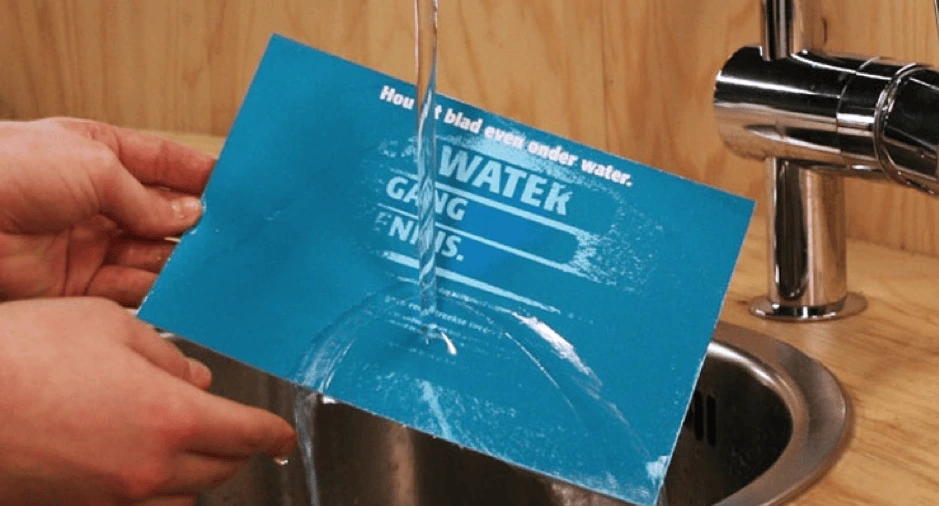
Not only did this direct mail campaign explain World Water Day’s campaign aim creatively, it also became an interactive piece of content. Interactive content has been proven to generate 2x more conversions than the alternative. That’s pretty genius, right?
Lucidpress: Click the image to use the template
Use one of our direct mail templates as inspiration for your own direct mail piece. Switch out colors, fonts and texts to create your direct mail postcard or flyer in seconds.
Browse all direct mail templates



DO emotionally engage customers
The second way to ensure your direct mail marketing campaign is a success is to make your audience feel something — any type of emotion. After all, there’s such a wide range of them. Emotion has been the marketer’s secret weapon for years. Various studies show that people rely on emotions, not just logical information or data, to make buying decisions.
Feelings of anger, disgust, affirmation and fear often top the list of emotions that work well in advertising.
A fantastic example of this comes from the Natural History Museum. In an attempt to educate local people about the danger of animal extinction, they sent an eraser to their audience with a quote about the topic.

Because their audience could see a visual representation of extinction in their daily lives, it made them stop to think about how serious it is… and want to act.
Pick an emotion and drive it home through your next direct mail campaign. You’ll soon see the impact emotion has on marketing—but the victories will be for your own brand.
DO put your own spin on it
For the most part, mailboxes aren’t fun environments. Bills, bank statements and lonely newspapers often clog up the mailbox marketing route. But, you can stand out by making your direct mail marketing campaign a little unique.
A fantastic way to achieve a little uniqueness is through juxtaposition. Can you think of a smart, innovative way to show how powerful your offering is by comparing it to something completely different?
Let’s take this direct mail campaign for example. Created by the theatre team behind a local performance of Macbeth, they wanted people to visit their show. Instead of online marketing, they exploited their direct mail opportunity and found a way to stand out in a mailbox.
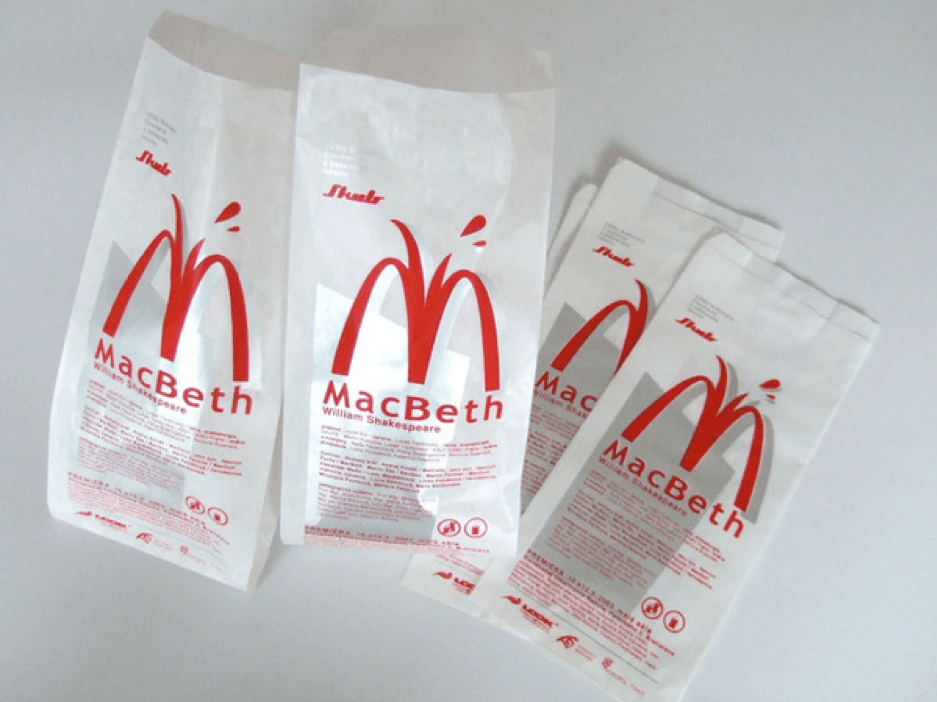
You’d probably never compare a Shakespeare play to a fast food joint, right? But that’s part of the reason why it works.
The juxtaposition of both elements makes you take a second take at the direct mail rather than toss it in the trash. This type of content experience (within direct mail marketing) is bound to make an impact on an audience, one who possibly has an interest in both but would never expect them to be paired together.
All in all, direct marketing provides you or your creative team with untold opportunities to lean into the creative, get weird and try new things. Plus direct mail marketing allows you to access new customers or get a feel for a prospective audience who might otherwise pass up your product or services.
DON’T skip doing the proverbial “leg day”
Leg day for direct mailing entails defining your audience and running some tests before you send out the direct mailers. Now, neither task needs to be a heavy lift. Defining your audience can be as simple as knowing who your product is best suited for and tailoring where and what neighborhoods you send the direct mail to based on this information.
Additionally, try sending a few flyers or direct mailers out to a small segment of your target audience. Make sure to include trackable tests, like a QR code or a custom URL (which we’ll touch on more momentarily).
DON’T forget to set goals for the campaign
Consider the following questions. As in, are you looking to drive brand awareness or boost sales of a particular product? Are you looking to assess brand awareness, and if so, how will you measure success or failture? Alternatively, if you want to increase sales, what is the target revenue or fiscal marker for your campaign? Specific goals will give you a benchmark to measure (and brag about) the campaign’s success, and it will help you drive improvement based on the results.
DON’T ignore the importance of a CTA
Simply put: You need a way to measure your goals and attribute which-sales-to-what-campaign-directive. Well, a CTA can help with that. Start by creating a custom URL to include in your direct mailer. This custom URL will empower you to track visits and sales from the website location, allowing you to attribute conversion and ROI to your direct mail campaign.
DON’T spam your customers
Inundating your customers with a lot of direct mail, emails and more is not the best way to get their attention. Sure, you’ll be top of mind, but it’ll be because you’re irritating them — not inspiring them or addressing a pain point. You don’t want to undermine the relationship you’ve worked so hard to build with them, so be mindful of who-you-send-what-where-and-when.
You’ve got mail — Lucidpress mail
If you couldn’t tell already, we’re big fans of direct mail. Now, the exciting part about Lucidpress is that we don’t just empower anyone to create compelling, effective content — we also make it easy to conduct a direct mail marketing campaign.
Choose from any of our direct mail marketing templates to customize and edit. Or, alternatively, if you’re feeling brave, you have the option to design your own. Then, all you’ll need to do is:
- Upload a .CSV file containing the details of people you’d like to target,
- OR use radial search to select a local delivery area.
Once selected, press the proverbial “go” button and use the direct mail marketing integration to send your mail directly within a matter of days. There’s no need to stop at your local post office with oodles of mail, thus, taking the stress out of building a direct mail marketing campaign.
As you can see, direct mail isn’t an old-school marketing technique that should’ve stayed in the 00’s. These tips, along with our new features, could be the combination you need to build a direct marketing campaign that drives excellent results for your business.
Learn more about the direct mail features in Lucidpress, and give it a test drive.
Bonus: Direct mail infographic
Craving more data? Check out this illustrative infographic about direct mail from our friends at Colourfast.

When you run your own business, you’re responsible for a lot. Aside from keeping the business running smoothly, you’re responsible for producing your product or service, hiring employees, marketing and managing your brand, and doing anything else your business requires.
Related: Direct mail marketing: Does it still work?
Today, let’s focus on the marketing aspect of your business.
In this article, we’ll focus on one type of direct marketing known as direct mail. Specifically, we’ll offer 10 suggestions for how to implement direct mail in innovative and creative ways. To start, let’s take a look at exactly what direct marketing and direct mail is.
What are direct marketing and direct mail?
Direct marketing is an assertive form of promotion in which a company reaches out directly to its target market. The point of these campaigns is to connect with consumers on an individual level, showing that they’re important to the company.
One example of this is telemarketer calls. Some other types of direct marketing:
- Email marketing
- Direct mail marketing
- Direct-response advertising
- Face-to-face selling
- Text marketing
- Distributed leaflets & flyers
Our focus today is direct mail—where advertising content is sent directly to a target market’s mailbox. The content could include letters, postcards, flyers, or anything mailed directly to a home or place of business.
Is direct mail still effective?
When you use direct mail correctly, it can be an extremely helpful tool in your advertising toolbox. You can “speak” directly to your audience and give them detailed information about your brand. In addition, you can easily track the success of a campaign.
However, you must practice care when you’re conducting these campaigns.
If you do this incorrectly, consumers will view the content as “junk mail.” Avoid this by providing consumers with content that is timely, relevant and important to them. You can also provide useful tools—for example, a coupon or promo code for your services.
How to use direct mail creatively
Now that we know what direct mail is and the benefits it can bring you, let’s brainstorm a few ways to use it for your brand. Below, we’ve gathered 10 innovative ways that you can use direct mail for your business.
1. Deliver discounts
One common-sense choice for direct mail marketing is to send out info about discounts and specials. This could mean one of two things. First, you could send out direct mail when you have a sale coming up.
Second, you could send out coupons for your service that are exclusive to your direct mail campaign. This is a good way to measure response and ROI, because you’ll know whenever a customer redeems the discount.
2. Send out samples
In addition to sending out discounts, you can send out samples to your customers. Of course, you should only do this if you have ample budget for the expense. It’s probably not the best tactic to use for your first campaign, but after you’ve gotten a handle on typical response rates.
If you can swing it, samples are a great way to attract new customers who don’t want to pay money to try out your product. In addition, if you have new products, samples are a great way to introduce current customers to your new products.
3. Offer reminders
Reminders are a cheap way to stay top-of-mind. You can send out reminders for upcoming events—for example, a realtor could announce an open house. You could also call attention to grand openings, deadlines or appointments. An example you’re probably already familiar with is receiving a letter from your doctor or dentist about your yearly check-up.
4. Share announcements
You can also use direct mail to deliver company announcements. This keeps your customers up-to-date on new developments such as different hours, new contact info, new products and more.
5. Use QR codes
QR (quick response) codes are a great way to connect your mail campaigns to your digital marketing efforts. They’re simple barcodes that are easy to print on a piece of mail and can be scanned by any smartphone.
One scan, and a QR code can be customized to take your customer anywhere you need. For example, you could design a QR code to take your customers to a specific landing page. Most people are familiar with QR codes these days, so their presence on your mail will be self-explanatory and easy to follow.
6. Add texture
When someone goes through their mail, the last thing you want is for yours to be immediately disregarded or tossed away as junk. One way to combat this is to make your mail more eye-catching than the rest.
There are a few ways to do this, but one of the easiest is to add some texture to your mail. For example, you can use embossed lettering to make it stand out when a customer grabs a handful of letters and newspapers.
7. Pop with 3D mailers
Using texture is a subtle way of differentiating your mail, but there is a more obvious way to set your mail apart. You can send out 3D mailers, such as a box or tube or any other 3D design. These will jump out to customers and spike their curiosity, prompting them to open your mail and take a look rather than just throwing it away.
8. Track personalized URLs
One way to track how well your direct mail is working is to use personalized URLs (PURLs). Like QR codes, they’re a digital extension of your message. PURLs will lead your customers to your website in a way that leaves a trackable footprint. You’ll easily be able to see how many of your customers responded to your direct mail campaign by checking the page’s stats.
9. Try augmented reality
When people think of augmented reality today, they think about games like Pokémon GO. However, augmented reality does have a place outside of entertainment. In fact, you can incorporate the idea of augmented reality into your direct mailing.
Usually, this is done through the use of an app. For example, in 2015, Toys R Us used augmented reality techniques to create a game out of a piece of their direct mail.
10. Wow with video in-print
Finally, there are video in-print techniques. This is a cool idea because it eliminates the middlemen (apps, websites, etc.) by including a video player directly in the mail. Right now, these are a bit pricey—but keep an eye on them for the future.
Key takeaway
When executed creatively, direct mail marketing can provide a huge boost to your promotions and brand awareness. Whether your goal is to be top-of-mind or to drive bottom-funnel sales, you can build a direct marketing campaign to match. By crafting professionally designed mailers, you’ll attract your target audience and reinforce loyalty among your customers.
Learn more about the new direct mail features in Lucidpress, and give it a test drive.
It’s getting harder to put your marketing messages in front of consumers. Increased digital competition, changing algorithms, and a crowded social media space mean you have to work hard to stand out.
So how are marketers breaking through the clutter? By revitalizing some tried-and-true, pre-digital strategies like direct mail.
Related: Direct mail marketing: Does it still work?
Receiving something in the mail is sure to get people’s attention. These 11 direct mail examples will inspire you to launch your own effective direct mail campaign. We’ve chosen each one because it showcases a particular strategy you can use to generated direct mail ideas for your own marketing pieces.
Bold text

Your central marketing message should be the first thing a recipient sees when they receive your direct mail piece. The Waterfront open house postcard has big, bold text taking up almost half of the design, so the main marketing message gets across right away.
If you design your own piece with bold text, just remember not to go overboard—you can overdo it. Balance the text with complementary images, and leave some space for the design to breathe.
Shaped text
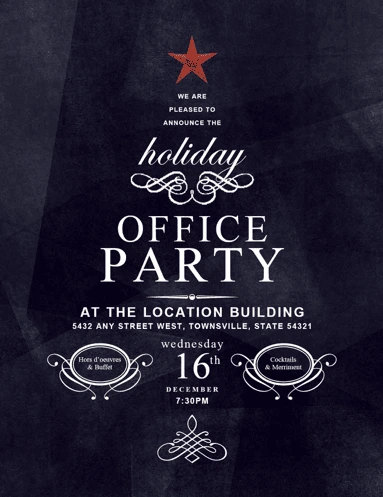
Another great way to get people’s attention is with interesting shapes. This office party invitation from Every Door Direct Mail organizes text into a Christmas tree shape, a surefire hit around the holidays. You can organize text into all sorts of shapes, from beer bottles to flowers. It’s a fun and creative way to add some eye-catching visual interest to your direct mail piece.
Stunning images

While your marketing pitch lives in the text, great images capture attention and evoke emotion. This Parisienne travel postcard gets viewers thinking about travel and romance with a pretty, black-and-white photograph of the Eiffel Tower. It’s good practice to choose an image that complements your brand and your offer, but the primary goal is to make a strong emotional connection.
Macro photography
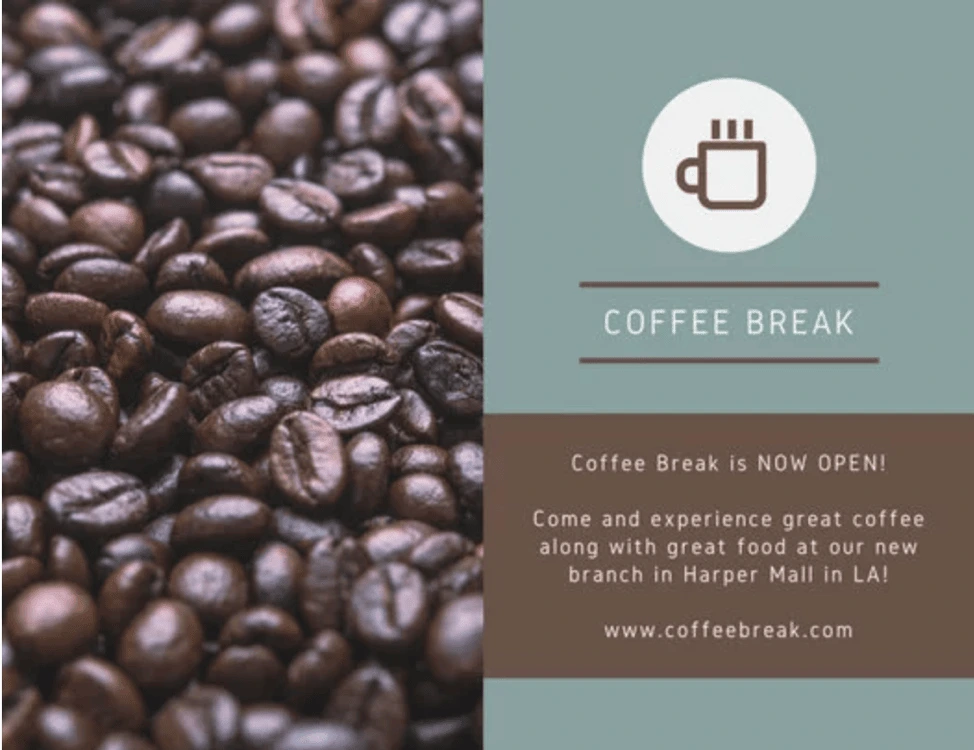
Direct mail pieces have to stand out from the stack of mail that people receive every day. Macro photography is a great way to provide a new perspective on a familiar object—and this direct mail piece from Canva puts this strategy to good use. Rather than a standard cup of coffee, this alluring photo evokes the scent, taste and tactile feel of coffee beans.
Of course, you don’t have to use coffee beans—or any food, for that matter. If there’s an object that represents your brand, product or service, use macro shots to highlight it. If you can use an image that’s personalized to your customers or local area, even better.
Eye-catching colors
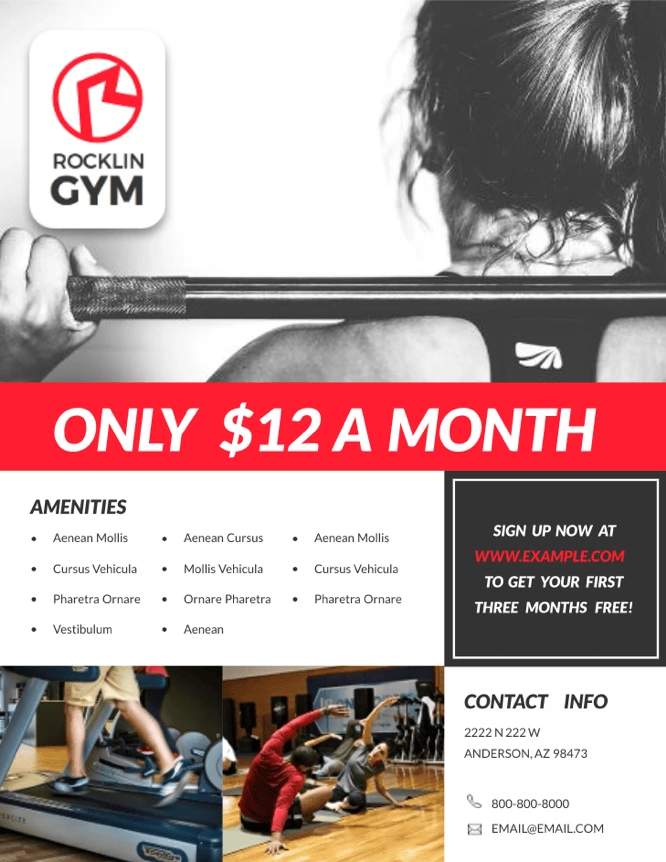
When you look in your mailbox on an average day, what do you see? Probably a sea of white (and off-white) envelopes, most of which look the same. The bright red stripe on this gym fitness flyer immediately stands out and draws attention to the value proposition. Be prudent with your color pops—an overly bright direct mail piece can look tacky and overwhelming. Stick with tasteful highlights like those showcased in this design.
Different shapes

Mailboxes are crammed full of standard envelopes and flyers every day. If your advertising needs to stand out, why not try a different shape? This modern tri-fold brochure will grab people’s attention not only with its color-blocked design, but also with an unusual shape. Folded pieces have a three-dimensional aspect to them, making it more likely to get noticed.
A personalized map

Personalization is a standard digital marketing tactic, but it’s more difficult to achieve in the direct mail space. Maps4Mail solved that by printing customized maps on each piece of mail, showing the recipient exactly where they need to go. The map is intuitive, personalized, and makes it easy for anyone to find your business. This is a great way to show customers you personally value their business as individuals.
If you don’t have the budget for such a granular campaign, you can still try other ways to add a personal touch to your direct mail. For example, you could include something specific to the local area, or you could include your signature.
Unusual materials
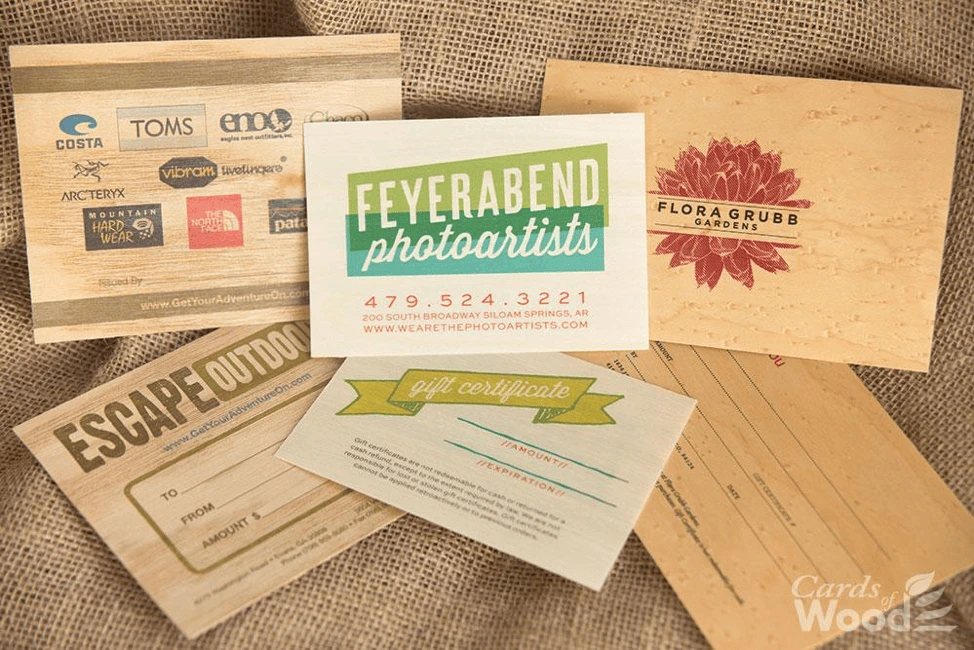
Most letters and flyers are printed on the same white paper. That’s not very exciting. If you can find materials or textures that stand out, you’ll have a big advantage over the competition. Heavy or textured paper work nicely, but if you really want to branch out, check this: These postcards from Cards of Wood are (as you would guess) made entirely of wood. Wood you believe it?
3D objects
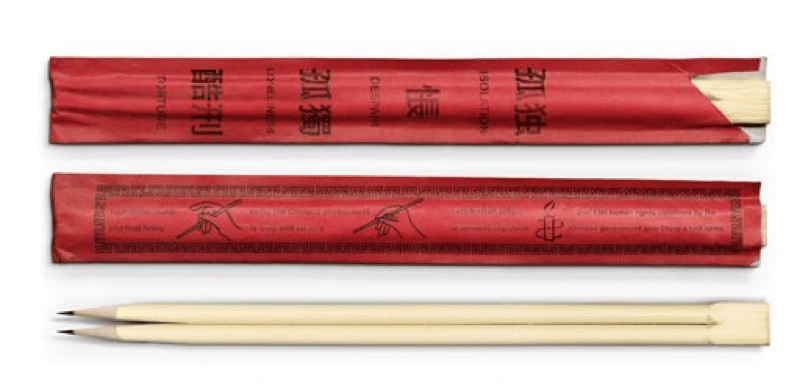
People are curious creatures, and we’re more likely to open packages that contain objects. If you can get your brand message across with an object, it can serve as a fantastic ad. Amnesty International sent out these pencil chopsticks to encourage people to write to the Chinese government. Thinking outside the box (or should we say inside) can get great results in direct mail because people spend more time with it.
Interactive mailers
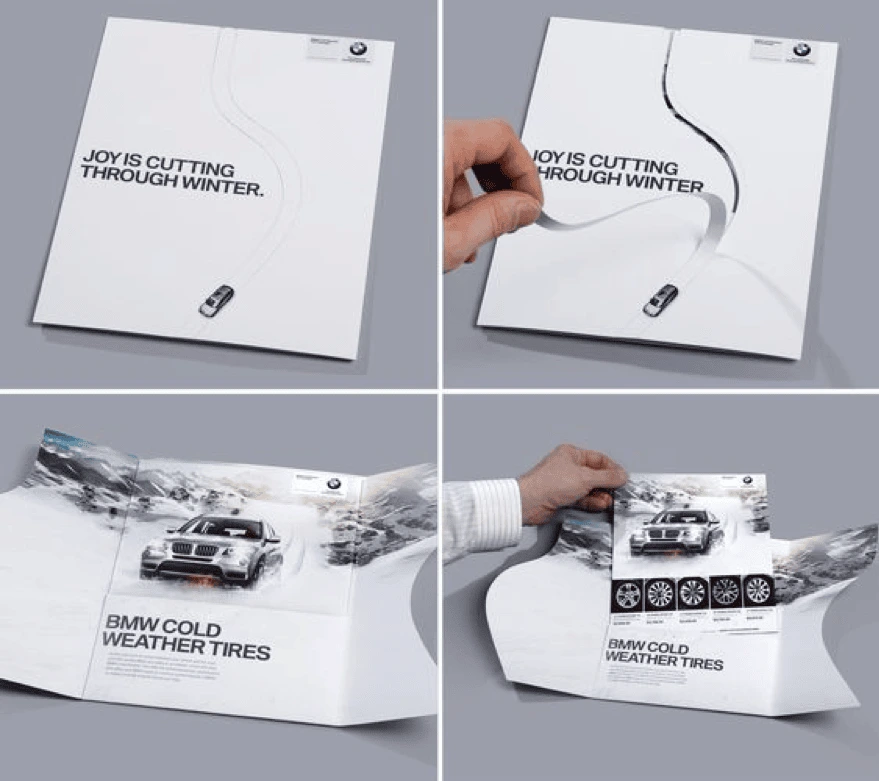
Not every brand can afford to design interactive mail pieces—but if you can, there might be no better way to connect with your customer. This piece from BMW had customers cutting a path through a wintery postcard to emphasize the reliability and control of their snow tires. Their combination of an envelope and mailer is great creative thinking.
Gifts
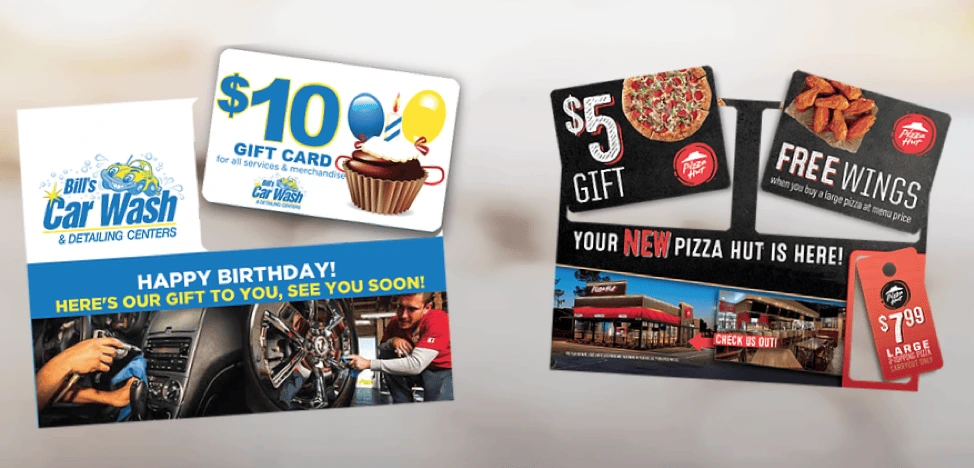
Many direct mail pieces focus on the value brands can provide to their customers—but you’ll have to go further if you want to stand out. A coupon is a good start, but that’s still fairly common. Consider including a punch-out gift card instead. It lets you take advantage of an unusual material (plastic) and give the recipient a gift. A great combination that’s tough to beat.
Key takeaway
People get a lot of mail they didn’t ask for, and different brands will find success with different types of direct mail. The most important thing is to stand out and provide real value to your audience. These examples should get your creative juices flowing and inspire the best direct mail campaign for your own marketing goals.
Ready to create your own direct mail designs in minutes? Check out our direct mail postcard templates.
Have you spent thousands of dollars on direct mail campaigns with no luck?
You shouldn’t chalk it up to failure just yet. Every great marketing campaign has a solid follow-up campaign behind it.
Sending out three months of direct mail, expecting a deal to happen, and giving up is not creating a business. It’s dabbling.
On average, it takes 12 touches for a deal to happen. However, 44% of people trying to get a deal under contract give up after the first follow-up.
Related: 5 best practices of highly effective direct mail marketing campaigns
I see a lot of real estate investors sending direct mail to find off-market deals. The biggest hurdle most have is that they spend hundreds or even thousands of dollars on a direct mail campaign without obtaining any leads. Then, they send out the same campaign again the following month with the same results.
This is when most people either quit sending direct mail or buy a new list to mail because the old list “wasn’t working.” Not getting any leads from mailing a list doesn’t mean that the list didn’t work—it just means the people you were mailing weren’t ready to sell. Direct mail marketing in real estate is all about timing.
To get a consistent pipeline of deals, you have to implement a great follow-up campaign. This article will walk you through how to set your follow-up strategy.
Following up across multiple channels
The strategy outlined below uses multiple channels to complement your direct mail campaign.
Don’t worry, it’s not going to cost you much more. In fact, it’s going to make those 12 touches a little less burdensome on your budget. Let’s dive in.
Build the right list for direct mail
The first step, of course, is to send out your direct mail. To get rolling with this, start by pulling the list that you’re going to mail.
You can use a list service company like ListSource to purchase a list of people to mail. The types of lists you should be targeting are problematic lists like:
- Probate
- Foreclosure
- Tax-delinquent
- Divorce
- Vacant house
Make sure that you’re filtering out people who have little to no equity. To do this, set your filters to include people with 60-100% equity in their property. This will give you enough breathing room to get the property at a discount.
The other criteria you need to meet is Last Sold Date. We’ve had people call us and say, “I just built this house for retirement three years ago. There’s no way I’m selling it.” Granted, this may not always be the case, but we set our Last Sold Date to 8 years ago or more.
Figure out your farm area
Figure out what your farm area will be starting out. Remember that you have a smaller budget, team, and amount of time as you build momentum. Your farm area will grow as your deal flow grows. Focus on mailing an area that you can comfortably mail consistently every month.
If you work in an office, figure out the radius you want to farm around your home and work. Starting out, we chose a 20-mile radius. The distance isn’t what’s important—it’s how long it takes you to get to the houses within this radius. You don’t want to miss deals because you’re spreading your leads out too far and can’t get to all your appointments quick enough.
We recommend keeping it within 45 minutes. This will give you time to schedule multiple appointments each day as you consistently mail homeowners over time and the lead volume increases.
There’s a cool trick on Free Map Tools that lets you drop a pin, set your desired radius, and get a list of all zip codes within that radius. With this, you can easily pick the zip codes for your farming area around your workplace and home.
Optimize your postcards
What you put on your postcards is up to you, and how postcards perform in each market varies. For our market, plain white postcards with a handwritten font perform the best. (When your prospect has a stack of ten postcards that look like ads and one that looks like a hand-written note, which do you think will stand out more to that person?)
Regardless of the design, make sure you include your company’s name along with your website. The people receiving these postcards will check to see that you’re a credible company before doing business with you. We put Breyer Home Buyers and www.eastatlhomebuyers.com on all our postcards to make it easy to find us online.
If you’re sending direct mail solely to people who are going through a divorce, then you can create a divorce landing page with a URL like www.yourcompany.com/divorce. This gives you the option to retarget visitors using Facebook Ads and Google AdWords. You can do this with any mailing list: tax-delinquent, vacant houses, foreclosures, etc.
Call recipients about your postcard
Your list provider can give you phone numbers for contacts within your farm area. If you keep them in an Excel spreadsheet, you can upload them into a dialer like MOJO. MOJO lets you call hundreds of people in a very condensed timeframe. For our business, we average 71 calls per hour. Of those 71 people, we reach around 30 per hour. We use virtual assistants to call for us, which saves our company significant amounts of money.
To use MOJO, you’ll need a Skype account. MOJO connects to Skype so you can make calls within the U.S. for free, even if you use a virtual assistant.
Remember that when you’re calling prospects to follow up on your direct mail, you should mention your company’s name and that you sent them a postcard. This will jog their memory and make it more likely that they’ll look at the postcard again.
Retarget prospects with Facebook
You can use Facebook and Google Ads to retarget your prospects. Retargeting is cheaper than marketing to cold prospects with these channels. And these prospects have already seen your direct mail, landed on your website, and received a call from you. When they see your ad and click on it, they’re more likely to convert, which provides you with a higher ROI.
The other benefit is that most of us are too busy to immediately respond to marketing. Maybe your prospects were taking their kids out to eat when they drove by the mailbox and got your postcard. Maybe they were waiting on a meeting to start when they looked up your website. Maybe they lost your postcard and couldn’t find you again. Regardless, retargeting helps you pop back up in front of your prospect when they need it most.
Send an SMS blast
There’s no replacing a phone call, but sending a text message is a great way to get in touch with people who don’t like talking on the phone. We use EZ Texting to follow up with people through text. We simply upload an Excel spreadsheet of our contacts, then blast the same message to the entire list.
We usually send out open-ended questions like “Have you sold your property yet?” But, there’s no magic message. The goal is to start a dialogue, so you can make an offer to buy their property.
We’ve gotten several properties under contract without ever speaking to the homeowners on the phone, by doing all the rapport-building and negotiation over text.
Leave voicemails on landlines
Tools like Sly Broadcast let you pre-record a voice message and send it to the phone numbers on your list. It’s important to note that this service only drops voicemails to landlines, not cell phones. Using this in conjunction with the text blast will make sure you’re touching all phone types.
MOJO Dialer also drops voicemails when you’re power-dialing, but the key difference is that you are actually calling someone and will have to speak with them if they answer. With Sly Broadcast, the phones don’t ring, but a voicemail shows up on their answering machine.
Schedule your follow-up campaign
When we’re planning our direct mail campaigns, we schedule the arrival date of those mail pieces—meaning that we know (within one day) when those mail pieces will be delivered. We usually have our mail dropped on Tuesday because our response rates are higher on Tuesday.
Here’s what our follow up campaign looks like:
- Week 1: Direct mail delivered on Tuesday
- Week 1: Begin Google AdWords and Facebook retargeting
- Week 2: Cold call prospects
- Week 3: Text prospects
- Week 4: Voicemail drop
- Week 5: Repeat mailing to the same list
- Week 6: Repeat cold calling to the same list
- Week 7: Repeat texts to the same list
- Week 8: Repeat voicemail drop to the same list
With retargeting, you set it up once and keep it running. We don’t stop the Facebook and AdWords campaigns. Your goal should be to contact each prospect with a phone call, a postcard, a text, and a voicemail drop each month.
Why you should always follow up
Homeowners usually aren’t ready to sell when you first reach out to them. Granted, sometimes we do get lucky and close a deal on the first mailing. But, it usually takes us at least three mailings to get a deal from a campaign.
If you label your direct mail campaign a failure because you haven’t gotten a deal right away, then you risk missing out on future leads and give yourself zero return on your investment.
If you look out over the year and set a goal for 5 deals to get the real estate investing ball rolling, you’ll create a marketing plan to reach that goal. However, if you keep changing your marketing strategy because you haven’t given yourself enough time to make it work, then you’ll never reach it.
Ready to create your own direct mail designs in minutes? Check out our direct mail postcard templates.
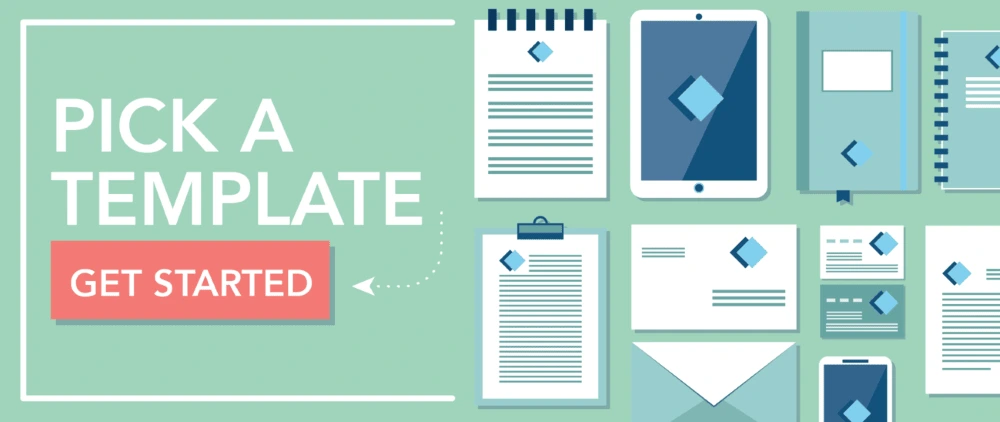
Or, learn more about the new direct mail features in Lucidpress and give it a test drive.
Last week I received a letter in my mailbox for the first time in a long time. It’s been ages since someone (even a company) sent me physical mail rather than going the easier route with email.
It really felt good to have something that I can touch and feel with my own hands.
Related: 11 best direct mail pieces to inspire your next campaign
Sometimes, the dull and boring side of advanced technology makes us realize we’ve come a long way. There was a time when people used to get a lot of mail in their mailboxes, especially in the form of promotional material.
Gradually, companies left that behind and considered it defunct. But in reality, direct mail is still a great way to engage with one’s audience.
Why? Because in our modern age, it provides a personal touch that email can never replicate. Data published by the Data & Marketing Association in 2016 showed that the response rate of direct mail increased 43% year-over-year. This is a huge leap from previous years.
Companies should know that it’s short-sighted to completely do away with direct mail. It’s still an effective and useful tool. To drive home the point, here are eleven reasons why every brand should (re-)consider direct mail.
1. You can achieve a higher ROI
Most companies set up online ads hoping to see better ROI because of the huge number of internet users.
But, direct mail can drive even better impact: a median ROI of 29% compared to online display at 16%.
When someone receives physical mail, it carries more weight (and not just literally). Customers are more likely to respond to communication that feels personal, and direct mail makes it easier to send that message.
2. Direct mail pairs well with digital marketing
If you want to build your own brand online or enhance the reputation of your company, digital marketing is usually the best place to start.
For many brands, this includes publishing SEO-optimized content and setting up Facebook ads. It usually doesn’t include direct mail… but maybe it should.
Direct mail can help you bridge the gap between the digital world and the real one. You can reach potential customers who might otherwise never hear about you—and you don’t always have to sacrifice data to do it.
For example, a digital marketing agency in our own state (Utah) included a scannable code on the back of one direct mail piece. They could track engagement with that code just like they would any other online campaign. They also included a Twitter hashtag that people could use to interact with the campaign. These techniques help to tie everything together, so their team got a holistic look at their campaign’s performance.
3. You can hold direct mail
This might seem obvious, but humans are sensory creatures. An email lives on your digital gadgets, where you’ll never be able to touch it. People can actually touch and feel the direct mail that a company sends to them, and because of that, it leaves a stronger impact.
This is especially valid for pieces that provide real-world value, like a free sample or discount coupon. Customers are more likely to remember and redeem those promotions than the ones they’re inundated with via email.
4. Attention, please!
When people check their mail, they take and go through everything they’ve received. It’s almost guaranteed that they will look at each and every piece, even if it’s only for a moment. Then they have to decide what to do with each piece—deciding which ones are worth saving and which ones are okay to throw away.
Conversely, when someone’s checking their email, they’re often engaged in other behaviors and environments that divide their attention. For example, they could be multi-tasking at work or watching TV on the couch. Since direct mail deals with fewer distractions, it benefits from better attention spans.
5. You can track direct mail
There are plenty of email & direct marketing tools to track the progress of your email campaigns. What about direct mail? Yes, it’s true that the process isn’t fully automated in the same way—but you can make them easier to track.
For example, you can designate a phone number or email address solely for the target audience of your direct mail campaigns. You can also create specialized landing pages with unique URLs. This will greatly improve the quality of your data and the accuracy of your success metrics.
6. All ages welcome
Any time you opt for a particular marketing strategy, it’s vital to understand which age groups that strategy serves.
In the case of email marketing campaigns or online advertisements, seniors are often left out because they adopt technology later than the younger generations. If seniors are a key demographic for you, you’re probably leaving money on the table.
Instead, consider reaching that audience with direct mail. And don’t assume seniors are the only ones—other audiences could benefit, too. Take a look at your audience and think about whether direct mail could extend your reach.
7. When others zig, you zag
Since digital marketing has so thoroughly transformed the landscape, many companies have quit using direct mail altogether. Just because fewer people are using it, however, doesn’t mean it’s an obsolete tool.
In fact, there’s a little bit of irony at play here: Your brand can stand out by reincorporating direct mail as part of your campaign. The high ROI speaks for its validity, and you can get the best of both worlds by adding physical mail to your digital campaign.
8. Direct mail can help you target specific audiences
We’re used to seeing the targeting capabilities of various social media platforms. But, did you know that direct mail can also target specific audiences?
For example, the USPS website has a tool called Every Door Direct Mail, which lets you send mail to addresses within a selected geographic area. This is the same system Lucidpress uses to send direct mail postcards from our platform to the local areas you want to target.
It’s not only about location, though. Address databases often contain other details you can use to target an audience: age, income, marital status & more. With these, you have granular control over who to send your direct mail to.
9. You can raise brand awareness
Are you trying to raise awareness of your brand? If you’re willing to build a campaign around that goal, direct mail can be a very effective way to achieve it.
As always, brand consistency is key, so keep your direct mail pieces consistent with overall branding.
You can earn extra points by including a coupon or another special offer, increasing the likelihood that your recipient will keep it around. The more times they view your direct mail piece, the more familiar your brand will feel to them.
10. Direct mail tickles the senses
Quick: name the five senses. Now, name the senses you can activate with a digital marketing campaign. Suddenly, your options are a lot more limited.
Sensory experience is a huge part of getting a response from an audience. If you’re only marketing online, you’re limiting yourself to sight and sound.
With direct mail, you can activate more senses like smell, taste and touch. (For example, think about those perfume ads you used to find in magazines.)
The more senses you can trigger, the more likely your customer will be moved by your message.
11. You can let your creative juices flow
In digital marketing, where best practices and A/B testing determine all, have you noticed that most company websites look… pretty similar?
Refreshingly, direct mail is a channel that brands can experiment with to create something new and innovative.
In fact, the more your mail stands out, the better. Take a look at some of the fun, creative ideas in this Pinterest board of direct mail marketing ideas:
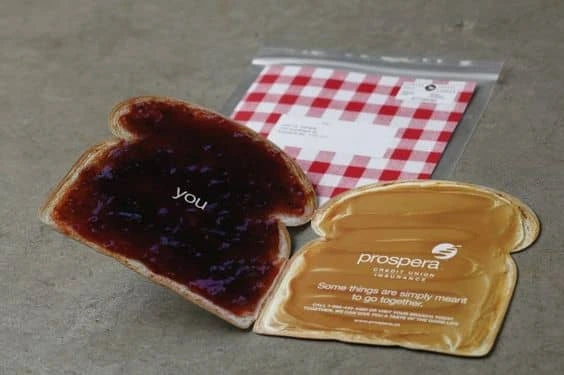
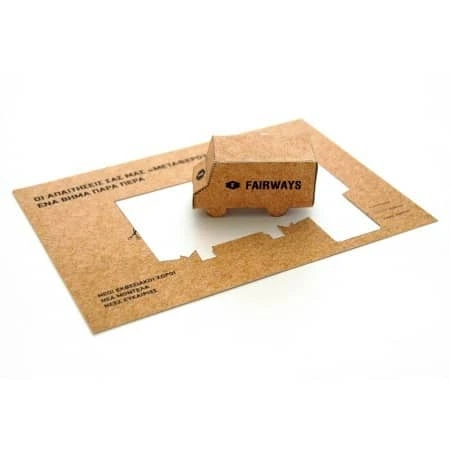
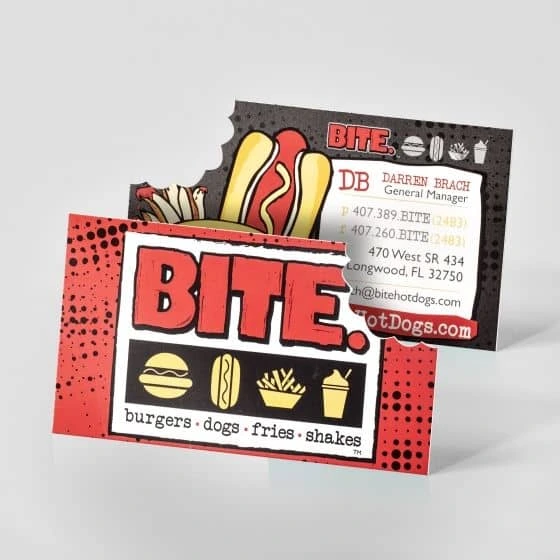
Key takeaway
Cutting direct mail from your marketing strategy because you assume it’s dead is misguided. Direct mail is still alive and well, and there are strong reasons to include it in a well-rounded campaign.
From higher ROI to stronger impact, brands are still reaping the benefits of direct mail today—and so can you. Bring these eleven reasons to your team the next time you’re planning a marketing campaign. They might just be surprised at the results.